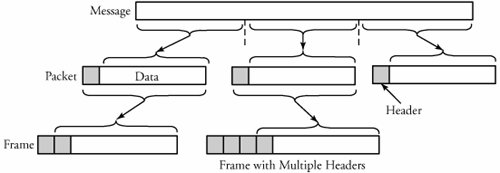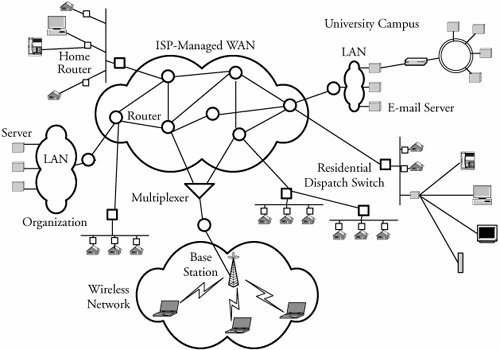Section 1.1. Basic Definitions in Data Networks
1.1. Basic Definitions in Data NetworksCommunication networks have become essential media for homes and businesses. The design of modern computer and communication networks must meet all the requirements for new communications applications. A ubiquitous broadband network is the goal of the networking industry. Communication services need to be available anywhere and anytime . The broadband network is required to support the exchange of multiple types of information, such as voice, video, and data, among multiple types of users, while satisfying the performance requirement of each individual application. Consequently, the expanding diversity of high-bandwidth communication applications calls for a unified, flexible, and efficient network. The design goal of modern communication networks is to meet all the networking demands and to integrate capabilities of networks in a broadband network. Packet-switched networks are the building blocks of computer communication systems in which data units known as packets flow across networks. The goal of a broadband packet-switched network is to provide flexible communication in handling all kinds of connections for a wide range of applications, such as telephone calls, data transfer, teleconferencing, video broadcasting, and distributed data processing. One obvious example for the form of traffic is multirate connections, whereby traffic containing several different bit rates flows to a communication node. The form of information in packet-switched networks is always digital bits. This kind of communication infrastructure is a significant improvement over the traditional telephone networks known as circuit-switched networks . 1.1.1. Packet Switching versus Circuit SwitchingCircuit-switched networks , as the basis of conventional telephone systems, were the only existing personal communication infrastructures prior to the invention of packet-switched networks. In the new communication structure, voice and computer data are treated the same, and both are handled in a unified network known as a packet-switched network, or simply an integrated data network. In conventional telephone networks, a circuit between two users must be established for a communication to occur. Circuit-switched networks require resources to be reserved for each pair of end users. This implies that no other users can use the already dedicated resources for the duration of network use. The reservation of network resources for each user results in an inefficient use of bandwidth for applications in which information transfer is bursty . Packet-switched networks with a unified, integrated data network infrastructure known as the Internet can provide a variety of communication services requiring different bandwidths. The advantage of having a unified, integrated data network is the flexibility to handle existing and future services with remarkably better performance and higher economical resource utilizations . An integrated data network can also derive the benefits of central network management, operation, and maintenance. Numerous requirements for integrated packed-switched networks are explored in later chapters:
Circuit-switched networking is preferred for real-time applications. However, the use of packet-switched networks, especially for the integration and transmission of voice and data, results in the far more efficient utilization of available bandwidth. Network resources can be shared among other eligible users. Packet-switched networks can span a large geographical area and comprise a web of switching nodes interconnected through transmission links. A network provides links among multiple users facilitating the transfer of information. To make efficient use of available resources, packet-switched networks dynamically allocate resources only when required. 1.1.2. Messages, Packets, and FramesA packet-switched network is organized as a multilevel hierarchy. In such networks, digital messages are fragmented into one or more smaller units of messages, each appended with a header to specify control information, such as the source and the destination addresses. This new unit of formatted message is called a packet , as shown in Figure 1.1. Packets are forwarded to a data network to be delivered to their destinations. In some circumstances, packets are also required to be attached together or further fragmented, forming a new packet known as a frame . Sometimes, a frame may be required to have multiple headers to carry out multiple tasks in multiple layers of a network, as shown in the figure. Figure 1.1. Creating packets and frames out of a raw digital message As shown in Figure 1.2, two packets, A and B, are being forwarded from one side of a network to the other side. Packet-switched networks can be viewed from either an external or an internal perspective. The external perspective focuses on the network services provided to the upper layers; the internal perspective, on the fundamentals of network topology , structure of communication protocols, and addressing schemes. Figure 1.2. A packet-switched network receiving various- sized packets to route out A single packet, as the smallest unit of data for networking, may even be split into multiple packets before transmission. This well-known technique is called packet fragmentation . Apart from measuring the delay and ensuring that a packet is correctly sent to its destination, we also focus on delivering and receiving packets in a correct sequence when the data is fragmented. The primary function of a network is directing the flow of data among the users. 1.1.3. The InternetThe Internet is the collection of hardware and software components that make up our global communication network. The Internet is indeed a collaboration of interconnected communication vehicles that can network all connected communicating devices and equipment and provide services to all distributed applications. It is almost impossible to plot an exact representation of the Internet, since it is continuously being expanded or altered . One way of imagining the Internet is shown in Figure 1.3, which illustrates a big-picture view of the worldwide computer network. Figure 1.3. The Internet, a global interconnected network To connect to the Internet, users need the services of an Internet service provider . Each country has international or national service providers, regional service providers, and local service providers. At the top of the hierarchy, national Internet service providers connect nations or provinces together. The traffic between each two national ISPs is very heavy. Two such ISPs are connected together through complex switching stations called network access points (NAPs). Each NAP has its own system administrator. In contrast, regional Internet service providers are smaller ISPs connected to a national ISP in a hierarchical chart. A router can operate as a device to connect to ISPs. Routers operate on the basis of one or more common routing protocols . In computer networks, the entities must agree on a protocol, a set of rules governing data communications and defining when and how two users can communicate with each other. Each regional ISP can give services to part of a province or a city. The lowest networking entity of the Internet is a local Internet service provider . A local ISP is connected to a regional ISP or directly to a national service provider and provides a direct service to end users called hosts . End users and systems are connected together by communication links . An organization that supplies services to its own employees can also be a local ISP. Figure 1.4 illustrates a different perspective of the global interconnected network. Imagine the global network in a hierarchical structure. Each ISP of a certain hierarchy or tier manages a number of other network domains at its lower hierarchy. The structure of such networks resembles the hierarchy of nature from the universe to atoms and molecules. Here, Tier 1, Tier 2, and Tier 3 represent, respectively, a national ISP, a regional ISP, and a local ISP. Figure 1.4. Hierarchy of networks 1.1.4. ISPs and Internetwork ComponentsFigure 1.5 shows an Internet service provider. Networks can be classified into two main categories: wide area networks (WANs) and local area networks (LANs). A wide area network can be as large as the entire infrastructure of the data network access system known as the Internet. Figure 1.5 shows several networks, including LANs and WANs. End systems are indirectly connected to each other through intermediate switching nodes known as packet routers , or simply routers . Switching devices are key components that allow the flow of information to be switched over other links. Meanwhile, multiple local area networks are interconnected using border routers to form a wide area network. These routers contain information about the network routes, and their tasks are to route packets to requested destinations. Figure 1.5. Overview of a regional Internet service provider (ISP) Multiple users accessing a single transmission medium at the same time are connected not only by switching nodes and interconnection links but also an access multiplexer . The multiplexer combines traffic from several nodes into a cumulative flow. This technique improves the bandwidth utilization efficiently . In Figure 1.5, we can see that some aggregated links from a WAN are multiplexed into one link directed to a wireless network . In most cases, the aggregated packets are forwarded through a major network access node, as seen in Figure 1.5 for the wireless infrastructure. A separate network managed by a network administrator is known as a domain , oran autonomous system . As an example of the local area network, a college campus network is connected to the Internet via a border router that connects the campus to an Internet service provider. ISP users are connected to access points of a WAN, as seen in Figure 1.5. Various ISPs can be interconnected through a high-speed router. Service providers have varying policies to overcome the problem of bandwidth allocations on routers. An ISP's routing server is conversant with the policies of all other service providers. Therefore, the routing server can direct the received routing information to an appropriate ISP. When a link failure occurs, in packet-switched networks, the neighboring nodes share the fault information with other nodes, resulting in updating the routing tables. This way, packets may get routed through alternative paths bypassing the fault. Building the routing table in a router is one of the principal challenges of packet-switched networks. Designing the routing table for large networks requires maintaining data pertaining to traffic patterns and network topology information. |
EAN: 2147483647
Pages: 211


